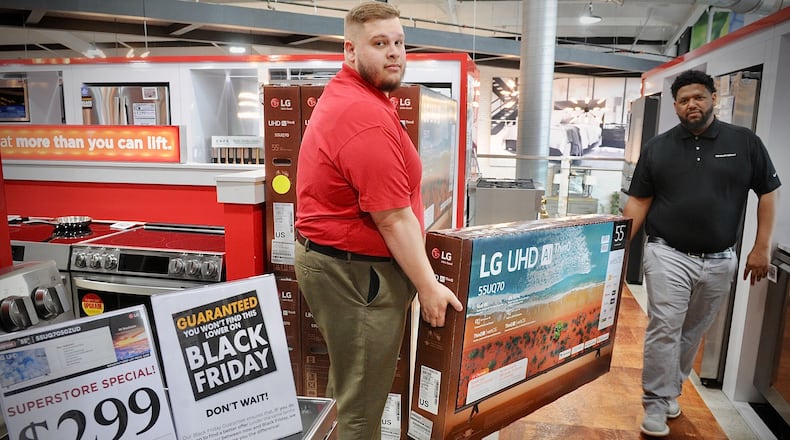The day after Thanksgiving, often referred to as Black Friday, is usually one of the highest shopping days of the year and begins an important time period of the year for retailers.
Retail is the nation’s largest private sector employer, supporting one in four U.S. jobs – 52 million working Americans, according to the NRF.
“Jobs in the Dayton region have grown by approximately 3% compared to a statewide job growth of about 5%,” said Brad Evans, UC Economics Center director of research.
The forecast also shows an expected decline of 4.4% for Cleveland region in 2023 over 2022 due to limited wage growth, he said.
“Both those regions have been hit just a little bit harder in certain areas in terms of jobs and wages during the pandemic and have been slower to come out of that as they continue to recover,” Evans said.
Statewide, researchers are anticipating a 0.7% increase in holiday spending over last year. Approximately $32.2 billion is expected to be spent statewide in 2023 during the October to December holiday season, according to the UC Economic Center’s forecast. This compares to nearly $32 billion in holiday relevant retail revenues during the 2022 holiday season.
Regionally, Youngstown is expected to experience the largest increase in relevant retail sales (6.8%) from the previous year followed by Columbus (5.2%) and Mansfield (3.7%). Ohio’s largest metro areas – Columbus, Cleveland, and Cincinnati – again are expected to account for more than half (55%) of estimated holiday relevant retail sales, researchers said.
Researchers are forecasting slower growth for the 2023 holiday season compared to recent years due to inflation, declining consumer confidence, increased housing costs, and high interest rates.
Since the projected holiday spending increase of 0.7% is lower than inflation, which was at 3.2% in October, consumers may be spending more but buying less.
“I think overall consumers will be spending more this year. I do think that Ohio’s consumers are facing some headwinds with high inflation, high interest rates right now,” Evans said.
Housing prices continue to rise, he said, so as people are dedicating more of their income toward their housing costs, it is taking away from their ability to make some additional purchases, Evans said.
Credit: TNS
Credit: TNS
“While inflation seems to be cooling, most experts agree that holiday sales growth is expected to slow. That said, it looks like holiday spending will finally rebound to pre-pandemic levels,” said Christopher Schutte, vice president of communications at the Greater Springfield Partnership.
With the pressures of inflation and housing costs, local organizations hope if consumers decide to be choosey that they pick local shops.
“It’s really kind of motivating people hopefully to support small businesses and support the community,” said Jessica Sands, marketing manager for the Downtown Dayton Partnership. “...We really hope that if people are going to be more selective with where they’re spending their dollars this year because of things like inflation and rising prices—that’s totally understandable—but we hope that they might choose to use their dollars in their own community.”
Nationally, holiday spending is projected to reach record highs in November and December, the National Retail Federation says. Spending is expected to increase between 3% and 4% over 2022 to between $957.3 billion and $966.6 billion.
The increase of 3-4% is a return to pre-pandemic levels. The holiday shopping season in 2019 saw an increase of 3.8% over 2018, according to the National Retail Federation. Holiday shopping increases during the pandemic included 9.1% in 2020 over 2019, 12.7% in 2021, and 5.4% in 2022.
“It is not surprising to see holiday sales growth returning to pre-pandemic levels,” said Matthew Shay, president and CEO of the National Retail Federation. “Overall household finances remain in good shape and will continue to support the consumer’s ability to spend.”
Solid job and wage growth will be contributing factors this holiday season, said Jack Kleinhenz, chief economist at the National Retail Federation.
“We expect spending to continue through the end of the year on a range of items and experiences, but at a slower pace,” Kleinhenz said.
The amount of spending on services instead of products is back in line with pre-pandemic trends, Kleinhenz said.
“Service spending growth is strong and is growing faster than goods spending,” Kleinhenz said.
E-commerce continues to see growth. Nationally, online shopping is expected to experience an increase of spending between 7% and 9% to a total of between $273.7 billion and $278.8 billion, the National Retail Federation says. That figure is up from $255.8 billion last year.
“As businesses are still grappling with the transitions and the impacts of COVID, you have that sort of dual competition between brick and mortar and folks shopping online,” said Jeff Payne, executive director of Downtown Middletown Inc. “What we really want to do is to encourage people to come out of their home, get away from the screen and then come and experience, one, the joy and the fun of walking through smaller spaces and seeing these unique kinds of things.”
Retailers are also confident more shoppers will return to in-person shopping this season.
“I think a lot of people are getting back into the normal routine of in-person shopping and feel more comfortable being around crowds, so I expect we’ll have a very successful Black Friday, as well as rest of the holiday shopping season,” said Allie West, business development specialist at the Greene Town Center.
The Greene has also seen pre-pandemic levels of crowds at its holiday events.
“I personally expect to see crowds of shoppers to grow as we move into the holiday season,” West said.
About the Author



